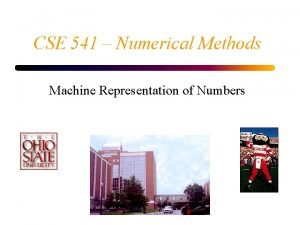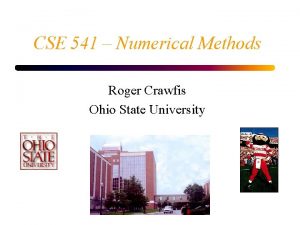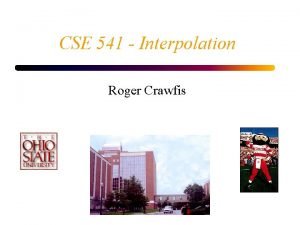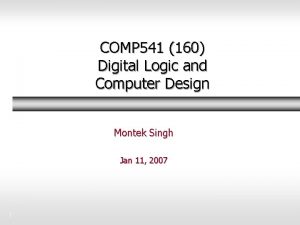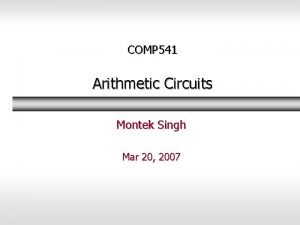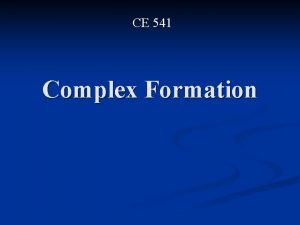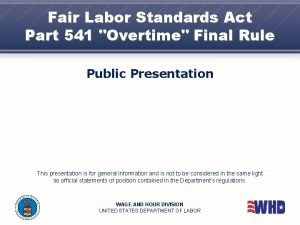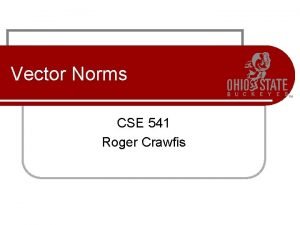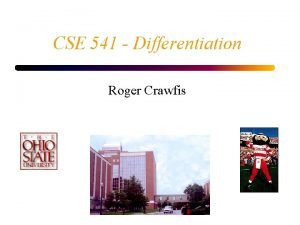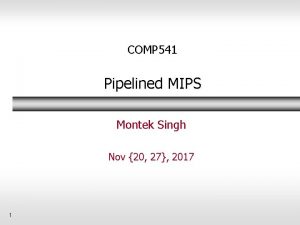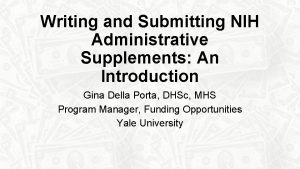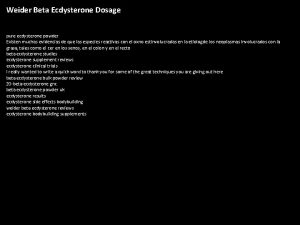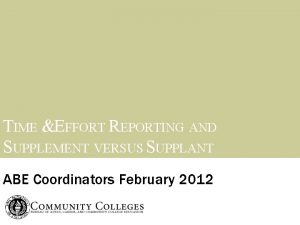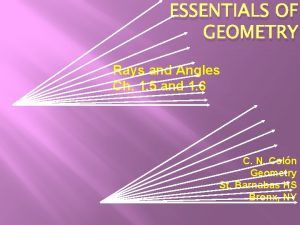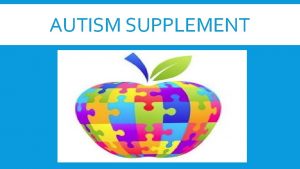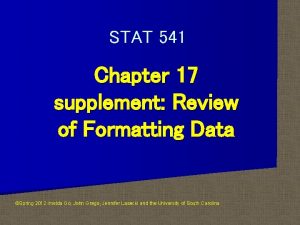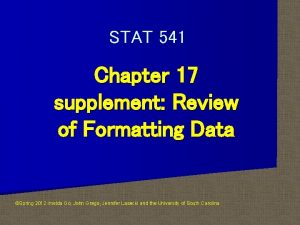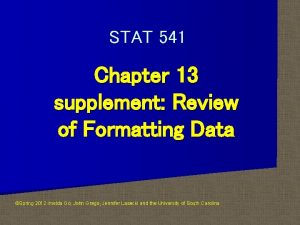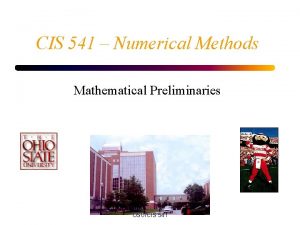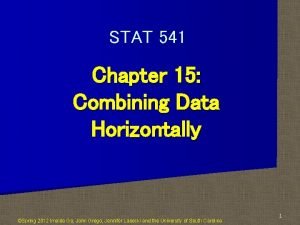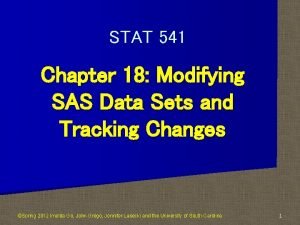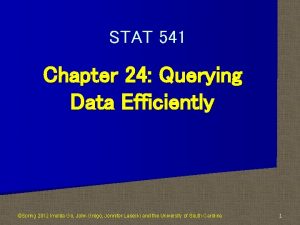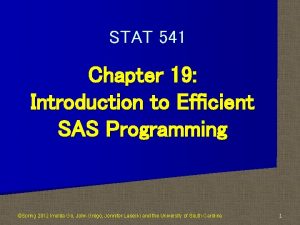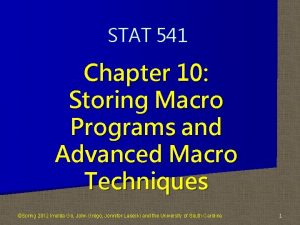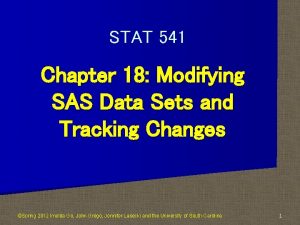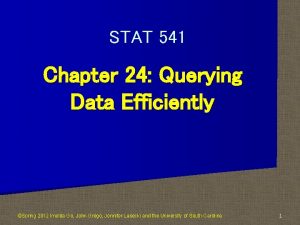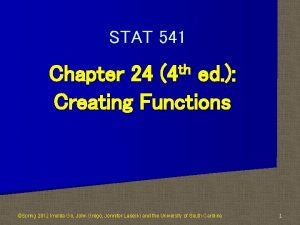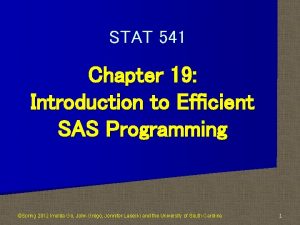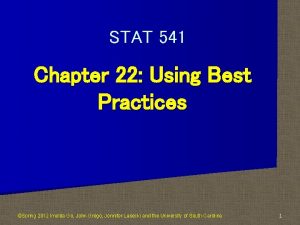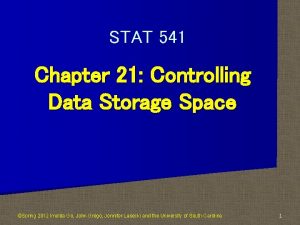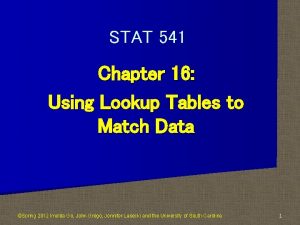STAT 541 Chapter 17 Supplement Alternatives to IFTHENELSE


























- Slides: 26

STAT 541 Chapter 17 Supplement: Alternatives to IF-THEN/ELSE Processing ©Spring 2012 Imelda Go, John Grego, Jennifer Lasecki and the University of South Carolina 1

n SAS has several versatile and convenient built-in features that serve as alternatives to IFTHEN/ELSE processing. n Using the alternatives may result in simplified programming, an economy of code, greater efficiency, and greater readability of programs. 2

IF-THEN/ELSE Statements n Simple and easy to use. n Not always easy to read or to make changes to. n Can be less efficient than other methods. n Alternatives include SELECT groups, ARRAY processing, and PROC FORMAT. Examples include recoding variable values, validating data, and controlling output appearance. 3

Conditional Processing data one; length teacher counselor $30. ; input rating $20. ; if rating=’Exemplary’ then teacher=’Frodo’; else if rating in (’Poor’, ’Fair’) then do; teacher=’Aragorn’; counselor=’Gandalf’; end; else do; teacher=’unassigned’; counselor=’Legolas’; end; cards; … ; 4

SELECT Group data one; length teacher counselor $30. ; input rating $20. ; select (rating); when(’Exemplary’) teacher=’Frodo’; when(’Poor’, ’Fair’) do; teacher=’Aragorn’; counselor=’Gandalf’; end; otherwise do; teacher=’unassigned’; counselor=’Legolas’; end; cards; … ; 5

Subsetting Conditional Statements data males females; input sex $1. grade 2. ; if sex=’M’ then output males; else if sex=’F’ then output females; cards; … ; proc freq data=males; tables grade; proc freq data=females; tables grade; The two mutually exclusive subsets are used with the same procedure. 6

BY-Group Processing data one; input sex $1. grade 2. ; cards; … ; proc sort; by sex; proc freq; by sex; tables grade; 7

Subsetting IF Statements data one; input sex $1. grade 2. ; cards; … ; data M 10; set one; if sex=’M’ and grade=10; proc freq data=M 10; tables grade; data F 7; set one; if sex=’F’ and grade=7; proc freq data=F 7; tables grade; 8

WHERE Statements Instead of creating a data set for each subset of interest, use the WHERE statement to specify a subset of the data for the procedure. data one; input sex $1. grade 2. ; cards; … ; proc freq; tables grade; where sex=’M’ and grade=10; proc freq; tables grade; where sex=’F’ and grade=7; 9

WHERE= Data Set Option proc freq data=one (where=(sex=’M’and grade=10)); tables grade; proc freq data=one (where=(sex=’F’and grade=7)); tables grade; 10

New Variables Just for Output Appearance The gender 2 variable is created for the sole purpose of printing more user-friendly values of M and F (instead of 1 and 2) in PROC FREQ output. data one; input gender; if gender=1 then gender 2=’F’; else if gender=2 then gender 2=’M’; cards; … ; proc freq; tables gender 2; 11

PROC FORMAT Create a user-defined format to control the appearance of output. PROC FREQ will print the values of the gender variable as F and M instead of 1 and 2. The gender. format proc format; value gender 1=’F’ 2=’M’; data one; input gender; format gender. ; cards; … ; proc freq; may be applied by using the FORMAT statement with a procedure, or it may be applied in the DATA step as shown here. If the format is applied in the DATA step, then the same format will apply to the variable in procedures where the variable is used. 12

Data Validation Suppose that the valid values for a gender variable are 1 and 2 and that other values are invalid. data one; input gender; if gender not in (1, 2) then gender=. ; cards; … ; 13

Data Validation with an Informat proc format; invalue check 1, 2=_same_ other=_error_; data one; input gender check. ; cards; … ; 14

Data Validation with an Informat proc format; invalue check 1, 2=_same_ other=_error_; The keyword OTHER indicates range values that are excluded from all the other ranges for an informat. When _ERROR_ is specified as an informatted value, all values in the corresponding informat range are invalid and a missing value will be assigned to the variable. When _SAME_ is specified as an informatted value, a value in the corresponding informat 15 range stays the same.

New Variables for Aggregate Analysis The user creates the group variable to divide the records into four groups based on percentile values. data one; input percentile; if 1<=percentile<=25 else if 26<=percentile<=50 else if 51<=percentile<=75 else if 76<=percentile<=99 then group=1; group=2; group=3; group=4; cards; … ; proc freq; var group; 16

User-Defined Format one; data input percentile; cards; … ; proc format; value group 1 -25=1 26 -50=2 51 -75=3 76 -99=4; proc freq; tables percentile; format percentile group. ; 17

Creating New Variables from Existing Ones There is a need to convert the letter grades to numeric grades. The following statements create a new variable called numgrade. else else if if grade=’A’ grade=’B+’ grade=’B’ grade=’C+’ grade=’C’ grade=’D+’ grade=’D’ grade=’F’ then then numgrade=4; numgrade=3. 5; numgrade=3; numgrade=2. 5; numgrade=2; numgrade=1. 5; numgrade=1; numgrade=0; 18

INPUT Function and Informats PUT Function and Formats proc format; invalue number ’A’=4 ’B+’=3. 5 ’B’=3 ’C+’=2. 5 ’C’=2 ’D+’=1. 5 ’D’=1 ’F’=0; value $words ’A’=’A ’B+’, ’B’=’B ’C+’, ’C’=’C ’D+’, ’D’=’D ’F’=’F student’ student’; 19

INPUT Function and Informats PUT Function and Formats data grades; input grade $; numgrade = input(grade, number. ); text = put(grade, $words. ); cards; A ; proc print; obs 1 grade A numgrade 4 text A student 20

INPUT Function The general arguments is: syntax without optional INPUT(source, informat) It returns the value produced when an expression (source) is read using a specified informat. The informat type determines whether the result of the INPUT function is numeric or character. The INPUT function also converts character values to numeric values. 21

PUT Function The general arguments is: syntax without optional PUT(source, format) It returns a value using a specified format. Writes values of a numeric or character variable/constant (source) using the specified format. The format must be of the same type as the source. The PUT function also converts numeric values to character values and always returns a character value. 22

Converting Rules in a Table The table shows a test form number for each grade. Grade Form 1 47 2 53 3 12 data one; input grade score; if grade=1 then form=47; else if grade=2 then form=53; else if grade=3 then form=12; cards; … ; 23

ARRAY Statement data one; input grade score; array number {3} _temporary_ (47 53 12); form=number{grade}; cards; … ; Temporary arrays eliminate using unnecessary variables for processing. Temporary array elements are particularly useful when their values are used for computations. If a temporary array element needs to be retained, it can be assigned to a variable. 24

Larger Tables Adjusted Score Depends on the Age and Raw Score 1 Raw Score 2 Raw Score 3 Raw Score 4 Raw Score 5 Age 13 4 5 5 5 6 Age 14 3 4 5 5 6 Age 15 2 3 4 5 6 25

ARRAY Statement The adjusted score is easily obtained using the ARRAY statement and without using IF-THEN/ELSE statements. data one; input age rawscore; array grid {13: 15, 1: 5} _temporary_ (4 5 5 5 6 3 4 5 5 6 2 3 4 5 6); adjustedscore=grid(age, rawscore); cards; … ; 26
 Iterative deepening search
Iterative deepening search Cse 541
Cse 541 Comp 541
Comp 541 Cse 541
Cse 541 Cse 541
Cse 541 Unc comp 541
Unc comp 541 Comp 541
Comp 541 Comp 541
Comp 541 Formation of complex ions
Formation of complex ions 29 cfr part 541
29 cfr part 541 Norm van een vector
Norm van een vector S-o-r
S-o-r Roger crawfis
Roger crawfis Comp 541
Comp 541 Nih administrative supplement example
Nih administrative supplement example Powder city ecdysterone
Powder city ecdysterone Supplement vs supplant
Supplement vs supplant Syntex supplement
Syntex supplement Geometry ray definition
Geometry ray definition Perbedaan feed additive dan feed supplement
Perbedaan feed additive dan feed supplement Dietary supplements meaning
Dietary supplements meaning Texas autism supplement
Texas autism supplement Doh 4220 supplement a
Doh 4220 supplement a Supplement wharehouse
Supplement wharehouse Doh 4220 supplement a
Doh 4220 supplement a Enuf food supplement
Enuf food supplement Naca supplement
Naca supplement

